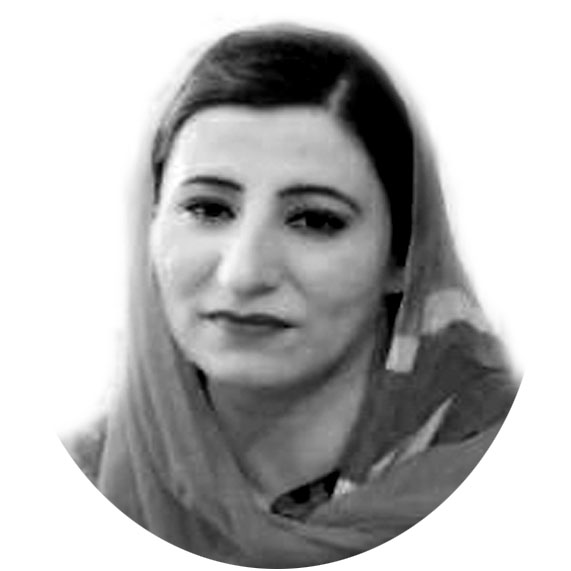Dr Samina Sabir
THE State Bank of Pakistan (SBP) has issued the monetary policy for next two months of 2020. The authorities have unchanged and fixed the interest rate at 13.25 % for coming months to target the future inflation. This interest rate is higher than the policy rate of China (4.15), India (5.15), Bangladesh (6), Nepal (6) and Sri Lanka (6.5). Evidences determine that mounting inflation has not caused by excessive demand but has caused by supply side factor owing to exorbitant upward movement in electricity prices, hike in gas prices, increase in transportation cost, increase in the prices of oil in international market, rapid increase in tax rate and exchange rate devaluation. In other words, inflation has surged up due to increase in the cost of production. Nonetheless this affects the production, consumers and economy altogether.
Furthermore, headline inflation measured with consumer price index (CPI) has reached 12.6% by the end of December 2019 from 12.7 in November 2019 and has slightly decreased. However food inflation has risen to 16.7 % at the end of December 2019 compared to 15 % in September 2019 in urban areas while in rural areas food inflation has increased massively from 15 % in September, 2019 to 19.7 % in December 2019 respectively. Further current wheat and sugar crises will accelerate expected food inflation. It is obvious that non-food inflation is a bit lower than food inflation in Pakistan but increasing trend has been observed in non-food inflation. Unemployment has increased to 6.2 % in 2019-2020 compared to 5.2 in the previous year. It is believed that there is a proportional relationship between policy rate and inflation. Therefore high inflation rate has increased the hardship and miseries of poor people and has also eroded their purchasing power. In the prevailing circumstances, SBP’s policy response of pegging interest rate at 13.25 % will further restrain the production and consumption, and will lead to job losses that resulting in lower aggregate demand and hence decrease GDP. The punch line is that upward trajectory in three variables like high interest rate, skyrocketing inflation rate and massive unemployment will push more and more people into the vicious cycle of poverty
One can ask the question, will pegging of interest rate at 13.25 % reduce the headline inflation? Obviously answer is no. The reason is that government and SBP should mull to diminish the supply shocks that are eliciting double digit inflation in Pakistan. A tight monetary policy functions in developed countries where people borrow money from banks to cater their daily needs. Population of Pakistan comprises 63 % of people categorized as transitory poor, 33 % are suffering from chronic poverty and 5 % are in extreme poverty. Therefore common people are not borrowing money from banks to meet their daily expenses and even they don’t have bank accounts. Controlling inflation should be the top priority and preference of government because persistent and high inflation is more like a regressive tax that is badly affecting the poor people in particular and economic development.
Industrial sector is a backbone of any country and it is a source of employment for skilled and unskilled workers but a high interest rate has acutely impacted industrial sector of Pakistan. According to the SBP, value added growth of industrial sector has declined to 1.4 % in 2019 from 4.9 in 2018 due to depreciation of Pakistan’s rupee and tight monetary policy. Put it differently, a sharp increase in interest rate has hurt industrial sector of Pakistan due to rising cost of borrowing and has hindered economic growth. Moreover, construction related industries have showed the low pace of public and private sector investment and affected economic growth. Similarly automobile industry has decelerated due to enormous depreciation of exchange rate as their parts are imported from other countries and are assembled in Pakistan. Slow growth of industrial sector has increased the unemployment that has suppressed the purchasing power of the people. The most important aspect is that decrease in investment in either sector cuts down the government tax revenues obtained from direct and indirect sources such as income tax, sales tax, expropriate tax etc.
For a time being, hot money inflows have increased in Pakistan due to high interest rate and it has definite impact on foreign reserves as the incumbent government has faced the severe problem of lack of accumulation of foreign reserves. Though this shows that confidence of foreign investors has revamped to make investment in Pakistan owing to reduction of balance of payment deficit and extended stability in current exchange rate. We know that there is an inverse relationship between bond prices and interest rates. Therefore high nominal interest rate leads to increase investment in treasury bills by foreign investors. The investment in TB will have short term or transitory impact on the economy but it can’t be sustainable in the long term. Nevertheless it should be kept in mind that there is risk factor involved in such type of capital inflows due to volatile macroeconomic indicators. Once interest rate will decrease, hot money will outflow to the alternative markets in other countries to earn high returns. It is absurdly believed that SBP has kept policy rate unchanged to attract hot money inflows without mulling over economic damages.
In the current situation of the economy, SBP should decrease interest rate and bring it to the moderate level around 5 % to 7 % to increase private and public investment to boost economic growth and development. There is a dire need to ease the business environment to attract foreign direct investment and to stimulate exports to crash pessimism of the people. This will increase employment, enhance productivity and income, increase foreign reserves through exports revenues and hence GDP will improve. The SBP should consider the core inflation rather than headline inflation while making its policy rate decisions.
—The writer is Assistant Professor, Institute of Economics, the University of Azad Jammu and Kashmir Muzaffarabad.










